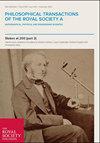实时混合实验中作动器延迟补偿的新方法
Philosophical Transactions of the Royal Society of London. Series A, Mathematical and Physical Sciences
Pub Date : 2001-09-15
DOI:10.1098/rsta.2001.0878
引用次数: 158
摘要
我们开发了一个在线实验系统,可以实时进行混合实验。它由计算机进行振动仿真并产生控制信号和液压作动器在控制信号的驱动下进行振动实验相结合。该系统补偿了执行器的延迟,从而使实验能够实时进行。我们评估了实验的稳定性相对于结构的质量在激励下,我们提出了一种新的补偿执行器延迟的方法,以提高稳定性条件。在该方法中,不仅利用位移,而且利用速度和加速度从仿真结果中产生补偿控制信号。该方法提供的稳定性判据(结构在激励下的质量与数值模型质量的允许比)比现有方法大3倍左右。本文章由计算机程序翻译,如有差异,请以英文原文为准。
A new method for compensating actuator delay in real–time hybrid experiments
We developed an on–line experimental system for conducting hybrid experiments in real time. It combines a computer, which conducts vibration simulation and generates a control signal, and a hydraulic actuator, which conducts a vibration experiment driven by the control signal. This system compensates for actuator delay and thus enables experiments to be carried out in real time. We evaluated the stability of the experiments with respect to the mass of the structure under excitation, and we developed a new method for compensating actuator delay in order to increase the stability condition. In this method, the compensated control signal is generated from the simulation results by using not only displacement but also velocity and acceleration. This method provides a stability criterion (allowable ratio of mass of the structure under excitation to that of a numerical model) about three times larger than that from the current method.
求助全文
通过发布文献求助,成功后即可免费获取论文全文。
去求助
来源期刊
自引率
0.00%
发文量
0

 求助内容:
求助内容: 应助结果提醒方式:
应助结果提醒方式:


